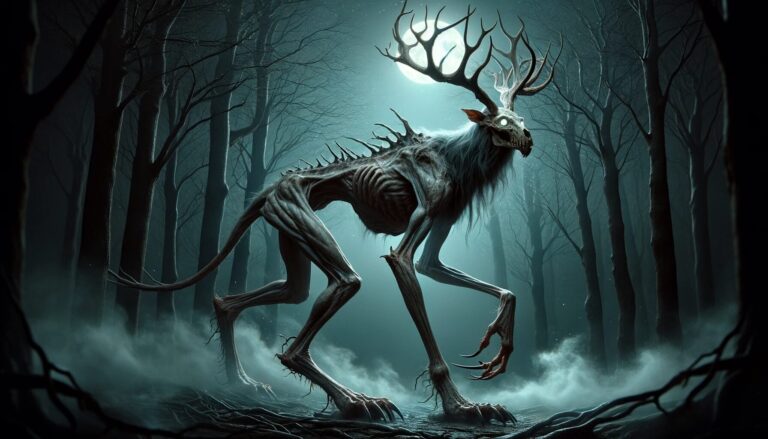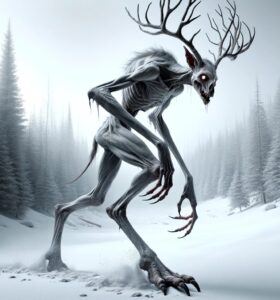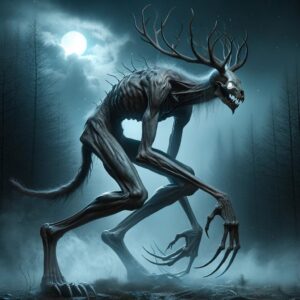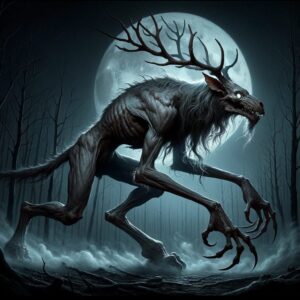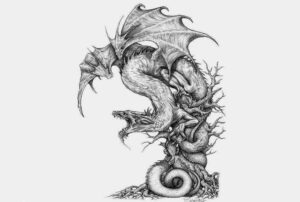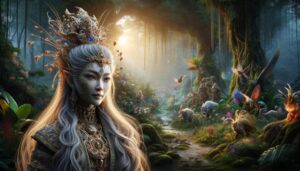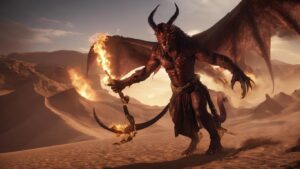Table of Contents
In legend, the Wendigo is said to be born from the actions of humans who resort to cannibalism in extreme conditions, such as during harsh winters when food is scarce. It is believed that consuming human flesh can transform a person into a Wendigo, causing them to become insatiable for more flesh and to develop supernatural powers. The Wendigo is often associated with cold and hunger, and it is seen as a symbol of the dangers of greed and the consequences of violating taboos.
Wendigo stories have been passed down through generations among indigenous communities, and the creature has also been a subject of fascination and inspiration in popular culture, including literature, films, and other forms of media. The Wendigo has become a symbol of the primal fear of starvation and the dark side of human nature.
The legend of the Wendigo has its origins in the folklore of various indigenous peoples in North America, particularly among the Algonquian-speaking tribes such as the Ojibwe, Cree, and Algonquin. The concept of the Wendigo has been a part of their oral traditions for centuries.
The specific origins and characteristics of the Wendigo can vary among different indigenous communities, but the common theme is the association with cannibalism and the fear of hunger during harsh winters. The Wendigo legend likely emerged as a cautionary tale to discourage cannibalism within these societies, as it was seen as a heinous act and a violation of cultural taboos.
While the exact origins of the Wendigo legend are difficult to trace due to its oral nature, it has been a part of Native American storytelling for generations. Over time, as European settlers and colonizers interacted with indigenous peoples, elements of the Wendigo legend were incorporated into the broader cultural folklore of North America.
In the modern era, the Wendigo has also become a popular subject in literature, horror stories, and popular culture, further solidifying its place in folklore and myth.
The physical description of the Wendigo can vary somewhat depending on the specific cultural and regional variations in the legend, but there are several common traits often associated with this mythical creature:
Emaciated Appearance: The Wendigo is typically described as extremely emaciated and skeletal, with its skin stretched tautly over its bones. This emaciation is a symbol of its insatiable hunger.
Tall and Gaunt: Wendigos are often portrayed as towering figures, much taller than an average human. Their height adds to their menacing and supernatural aura.
Pale Skin: They are usually depicted with sickly, almost white or ashen skin, which contrasts with their dark, sunken eyes.
Sunken Eyes: The eyes of a Wendigo are often described as sunken deep into their sockets, giving them a sinister and hollow appearance.
Distorted Face: Some legends describe the Wendigo as having a distorted or elongated face, with sharp, jagged teeth, and a constantly ravenous expression.
Antler-Like Horns: In some versions of the Wendigo myth, the creature is said to have antler-like growths on its head. These protrusions can vary in size and shape.
Long, Clawed Limbs: Wendigos are often depicted with long, bony fingers ending in sharp, claw-like nails that they use to capture their prey.
Tattered Clothing: Some depictions show the Wendigo wearing tattered, ragged clothing, which may be remnants of its former human identity.
Personality
The personality of the Wendigo in folklore and popular culture is typically characterized by a few key traits:
Malevolence: The Wendigo is generally portrayed as a malevolent and evil being. It is driven by an insatiable hunger for human flesh and is often associated with cannibalism. This monstrous appetite for human flesh is one of the defining features of its personality.
Greed and Cannibalism: Wendigos are often seen as symbols of greed and the consequences of selfish actions. They are believed to be humans who have resorted to cannibalism in extreme conditions, and this act is seen as a manifestation of their greed and lack of compassion.
No Mercy: Wendigos are often depicted as relentless and merciless predators. They are said to hunt humans and have a voracious appetite, showing no remorse or empathy for their victims.
Loneliness: In some interpretations, Wendigos are portrayed as lonely and tormented beings, forever cursed by their transformation into monsters. This loneliness may add a tragic dimension to their personality.
Supernatural Powers: Depending on the version of the legend, Wendigos may possess supernatural abilities, such as the ability to mimic human voices or control the weather. These powers add to their otherworldly and terrifying nature.
Madness: The transformation into a Wendigo is often associated with madness and a loss of humanity. This madness can further contribute to their unpredictable and dangerous behavior.
In various interpretations of the Wendigo legend, this mythical creature is often associated with supernatural abilities and powers. These abilities can vary depending on the specific folklore or story, but some common supernatural attributes and powers attributed to the Wendigo include:
Invisibility: In some versions of the legend, Wendigos are said to have the ability to become invisible or to blend seamlessly into their surroundings, making them formidable and elusive predators.
Mimicry: Wendigos are sometimes believed to possess the power of mimicry, allowing them to imitate the voices of humans or other creatures. This ability can be used to lure potential victims into their grasp.
Control Over Winter: Given their association with cold and harsh winters, Wendigos are sometimes thought to have control over the weather and the ability to bring about blizzards or cold snaps. This power adds to their role as agents of winter’s cruelty.
Shape-Shifting: In certain versions of the myth, Wendigos are capable of shape-shifting, allowing them to take on different forms and appearances to deceive or terrify their prey.
Supernatural Strength: Wendigos are often depicted as possessing immense physical strength, making them formidable opponents in physical confrontations.
Immortality: Some interpretations suggest that Wendigos are immortal or nearly impossible to kill, making them enduring and unrelenting threats.
Hypnotic Gaze: Wendigos may be able to use their gaze to hypnotize or paralyze their victims, rendering them helpless.
In Modern Usage and Symbolism
In modern usage and symbolism, the Wendigo continues to be a powerful and multifaceted symbol with various interpretations and applications:
Horror Genre: The Wendigo has become a popular figure in the horror genre, appearing in literature, films, video games, and other forms of entertainment. It is often used to evoke fear, dread, and supernatural terror.
Symbol of Greed and Cannibalism: The Wendigo is seen as a symbol of the darker aspects of human nature, such as greed, cannibalism, and the consequences of selfish actions. It is often used to explore themes of moral decay and the corrupting influence of desire.
Metaphor for Environmental Destruction: Some contemporary interpretations of the Wendigo draw parallels between its insatiable hunger and the destructive tendencies of human beings toward the environment. It is used as a symbol of overconsumption and the ecological consequences of unchecked greed.
Cultural Sensitivity: In modern discussions, there is a growing awareness of the cultural significance of the Wendigo in indigenous folklore. Some people emphasize the importance of respecting and understanding the cultural context in which the Wendigo legend originates and caution against appropriating or misrepresenting it.
Psychological Symbolism: The Wendigo has also been interpreted as a metaphor for various psychological and emotional struggles, such as addiction, obsession, and the feeling of being consumed by one’s own desires.
Commentary on Isolation: In some modern adaptations, the Wendigo is used to explore themes of isolation and loneliness, reflecting the idea that those who become Wendigos are cut off from humanity and forever tormented by their transformation.
Pop Culture References: The Wendigo continues to make appearances in popular culture, including in TV shows, comics, and other media. It remains a source of inspiration for creators looking to tap into its eerie and unsettling qualities.
Wendigo is a versatile and enduring symbol that can be applied in various contexts to explore a range of themes, from the supernatural and horrific to the moral and ecological. Its significance and interpretation may vary depending on the medium and the cultural sensitivity with which it is handled.
Ralated and similar creatures
Skinwalker (Navajo Mythology): In Navajo mythology, a skinwalker is a malevolent witch who has the ability to transform into different animals. Like the Wendigo, the skinwalker is associated with dark magic and harmful intent.
Ghoul (Middle Eastern Folklore): Ghouls are creatures from Arabian folklore known for their association with the consumption of human flesh. They share some thematic similarities with the Wendigo, especially in their cannibalistic tendencies.
Rakshasa (Hindu Mythology): Rakshasas are supernatural beings in Hindu mythology known for their malevolence and shape-shifting abilities. They often prey on humans and are considered as powerful and evil entities.
Baba Yaga (Slavic Folklore): Baba Yaga is a witch-like figure in Slavic folklore who lives in a hut that stands on chicken legs. She is often portrayed as a fearsome and unpredictable character with cannibalistic tendencies.
Kumiho (Korean Mythology): The Kumiho, also known as the nine-tailed fox, is a shape-shifting creature that can appear as a beautiful woman. While not necessarily associated with cannibalism, they are known for their deceptive and often malicious intentions.
Chupacabra (Latin American Folklore): The Chupacabra is a creature in Latin American folklore believed to drain the blood of livestock, particularly goats. It is often depicted as a fearsome, blood-sucking monster.
Yowie (Australian Aboriginal Mythology): The Yowie is Australia’s version of Bigfoot or Sasquatch. It is a humanoid cryptid said to inhabit the wilderness. While it is not necessarily associated with cannibalism, it shares similarities with the concept of a mysterious and elusive creature in the wilderness.
Yeti (Himalayan Folklore): The Yeti, or “Abominable Snowman,” is a legendary ape-like creature said to inhabit the Himalayan mountains. Like the Wendigo, it is often depicted as a mysterious and elusive figure in the wilderness.
Wraiths and Ghouls (Western Horror Lore): In Western horror lore, wraiths and ghouls are undead creatures known for their malevolence and association with death. They may share some thematic elements with the Wendigo, particularly in their eerie and predatory nature.
These creatures and legends vary in their cultural contexts and specific attributes, but they often serve as cautionary tales or embodiments of fear and the unknown. Each culture’s mythology and folklore contribute to the rich tapestry of supernatural beings and entities that continue to captivate our imaginations and explore the darker aspects of human existence.
FAQ
What is a Wendigo?
A Wendigo is a mythical creature from Algonquian folklore.
How is the Wendigo described in legends?
It's often described as a gaunt, emaciated figure with pale skin, sharp teeth, and glowing eyes.
What is the Wendigo legend associated with?
The legend is associated with cannibalism, greed, and the transformation of people into Wendigos through consumption of human flesh.
Is the Wendigo considered real?
No, the Wendigo is a mythical creature with no scientific evidence of its existence.
Where do the origins of the Wendigo legend lie?
The Wendigo legend originates from the folklore of Indigenous peoples, particularly the Algonquian tribes in North America.
Are there modern adaptations of the Wendigo legend?
Yes, the Wendigo legend has been incorporated into literature, films, and video games.
Have there been any documented sightings of the Wendigo?
No credible or documented sightings of the Wendigo exist.
What are some common characteristics of the Wendigo in various legends?
Common characteristics include a towering and skeletal appearance, insatiable hunger for human flesh, and supernatural abilities.
Can someone become a Wendigo in real life?
No, the idea of becoming a Wendigo through cannibalism is a mythical concept and not based on reality.
In which regions is the Wendigo legend most prevalent?
The Wendigo legend is most prevalent in the Northern United States and Canada, where Algonquian tribes historically lived.
What role does the Wendigo play in Indigenous folklore?
In Indigenous folklore, the Wendigo serves as a cautionary tale about the consequences of greed, selfishness, and resorting to extreme measures to survive.
How has the Wendigo been portrayed in popular culture?
The Wendigo has been depicted in various ways in popular culture, from horror movies to role-playing games, often as a terrifying and malevolent creature.
Are there any known rituals or practices associated with the Wendigo legend?
Some Indigenous communities have rituals and ceremonies to protect against the influence of the Wendigo legend or to address spiritual concerns related to it.
Are there any real-life explanations for the Wendigo legend?
Some scholars suggest that the Wendigo legend may have originated as a way to discourage cannibalism during times of extreme hardship or famine.
Can the Wendigo be defeated or appeased in legend?
In some versions of the legend, the Wendigo can be defeated through various means, such as purification rituals, or by showing kindness and generosity.
